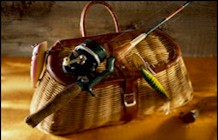CHALLIS — Resembling a small-town parade, anglers line the
banks of the clear, low-flowing Salmon River north of Challis as
they pelt the water with an arsenal of lures in a display of
synchronized casting.
Each angler, from Idaho, Utah, California, Wyoming and dozens
of other places, casts in hopes of hooking one spawning steelhead.
“They give you quite a tug,” says Stewart Nelson of Inkom.
“But it’s a slow sport. It’s just nice to get out.”
Nelson was one of the lucky anglers near Ellis. Out of nearly
100 fishermen, he was one of a couple dozen who managed to hook
and land a fish for the day.
According to check station records, it takes an average of 31
hours for an angler to catch a steelhead, nearly 43 hours to catch
a hatchery-run fish that may be kept.
“It’s definitely a challenge,” says Nelson. “It takes a
lot more patience than catching a trout.”
Amidst the roar of the river and the hoard of anglers in a few
hot spots, the beauty of central Idaho pee
ks through the cottonwoods and willows that line the banks.
Just a few miles from Ellis, anglers stand in the river,
casting into the ageless stream that flows through the canyon and
cliffs. Geese rest to their left in one of the still eddies, and
great blue heron fishes for lunch in a pond of back water.
Other anglers aboard drift boats glide through the rapids,
passing by the solitary fishermen, searching for the next hole of
resting steelhead.
“The biggest thing about steelheading is, you can stay in a
hole and fish all day and not catch anything,” says Earl Purser
of Pocatello. “Then a run can come through and you can catch one
right after another.
“I have been fishing for steelhead for four years,” he
continued. “They are a real strong fish, but you just have to
have a lot of patience. This year the fishing has been slow, but
steady.”
This year’s steelhead run is an estimated 115,000 fish, which
will cross lower Granite Dam before April 30. This is the largest
run since the 1992-93 season, when over 120,000 fish made their
way to spawning grounds.
Since 1993, an average of 70 to 87 thousand steelhead have made
their way from the Pacific Ocean.
The fish making the trek to Stanley started last summer. They
have made their way home after crossing eight dams and thousands
of fishermen on their 900-mile journey.
Fish going to the Pahsimeroi River travel about 844 miles.
“This time of year, you just have to find a hole and fish,”
says Jon Jensen, 12-year veteran from Idaho Falls. “You know
they are moving upriver.
“I really enjoy fishing for them,” he continued. “It’s
a kick hooking a big steelhead. It can be a real rush.”
The steelhead season will close April 30 and open again Sept.
Catching Steelhead
Just like all fishermen, seasoned steelheaders have their own
methods of catching and landing a lunker. Here are a few tips from
the pros on tackle for spring steelhead fishing.
Bobber and jig — Jigs should be pink, black, chartreuse,
reds and purple. Or, instead of a jig, just use a hook with shrimp
or sucker meat. A bobber is used to keep the jig from getting hung
up in rocks and debris on the bottom of the stream. Position the
bobber to keep the jig about six inches to a foot above the stream
bottom.
Eggs and sinker — Beg, borrow or steal some steelhead eggs
(roe), place them in a red mesh cloth and tie it to the fish hook.
Place a sinker about a foot to 18 inches up the line, so the eggs
will float off the bottom.
Flies — Use streamer flies in reds, yellows, pinks, black
or orange. Tie some crystal flash in the tail. Woolly buggers or
any leach pattern in darker colors can work. Some anglers hook a
small piece of night crawler or shrimp to the hook.
Flies need to be weighted to get them near the bottom of the
stream.
These same methods will also work with fall fishing, but
anglers can also include hardware such as spoons and spinners.





